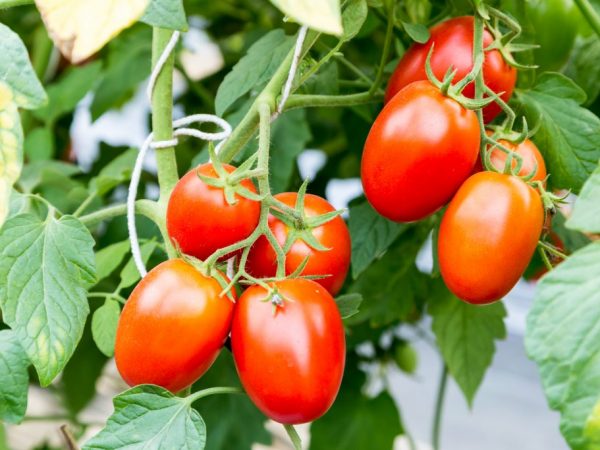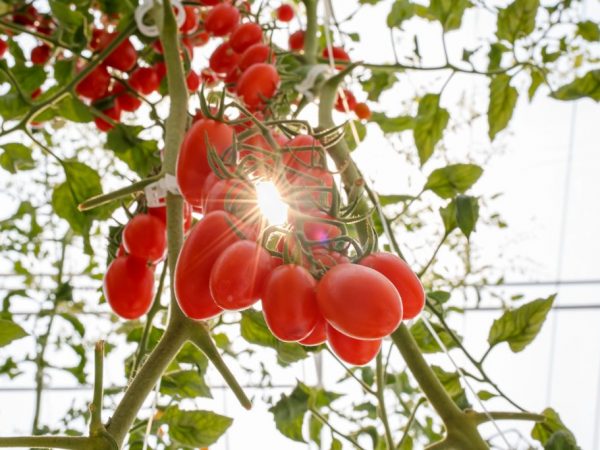Characteristics of Chio Chio San tomatoes
The Chio Chio San tomato is one of the most sought-after varieties among summer residents. It combines high yield and excellent fruit quality.

Characteristics of Chio Chio San tomatoes
Due to its unpretentiousness and resistance to temperature extremes, tomato grows well throughout Russia, except for its northern regions. The variety is really very good and, moreover, versatile, as it is suitable for both salad and preservation.
Characteristic
There are few gardeners who are not familiar with the Chio Chio San tomato variety. Its varietal characteristics are the result of long-term work of breeders.
Description of the variety
The variety belongs to the first generation (f1) hybrids, so the harvested seeds do not retain varietal characteristics. Every year for the cultivation of this crop, it is necessary to purchase planting material.
In the description of the Chio Chio San tomatoes, it is indicated that they are resistant to various diseases, as well as to sudden changes in temperature. High-yielding variety. More than 10 kilograms of fruit can be obtained from one square meter of land.
Description of the bush
The plant is very tall. Shoots, with proper care, reach a height of more than two meters. Since the bush does not have a stem, it must be formed. Higher productivity guarantees the formation of a bush in two shoots. Timely removal of stepsons and a garter is important. Heavy bunches of tomatoes are also tied up as they ripen.
The ovary begins to form after 8-9 leaves and then after every third. The leaves are small, dark green, heavily pubescent, like the stem of the plant.
Description of fruits
Chio Chio San tomatoes look like cherry tomatoes, but larger. Each of them weighs about 35-45 grams. The fruits are oval in shape and can vary in color from red to deep pink. Also tomatoes can be characterized as follows:
- the walls are thick, fleshy;
- seed chambers are small, with few small seeds;
- the pulp is juicy, moderately firm;
- the taste is pronounced tomato, sweet.
Due to their small size, the fruits are excellent for canning as a whole, and also look good in combined blanks. They are used to prepare fresh salads and sauces. Thanks to the elastic skin, tomatoes retain their presentation for a long time and easily tolerate transportation.
Growing seedlings
Like most varieties, this variety is grown in seedlings. To get a good harvest, you need to take care of the quality of the planting material. It is best to grow seedlings yourself, but for this you need to know how to do it correctly. Mistakes can spoil the seedlings, and the desired result will not be obtained.
Planting seeds
The seeds of the Chio Chio San tomatoes are very small, which makes planting difficult. The planting depth of seeds should not exceed 0.5 - 1 centimeter. Otherwise, the sprout will not be able to hatch normally.
Planting material must be processed before planting. To do this, the seeds are soaked in a weak solution of potassium permanganate for 1-2 hours. After they are planted in prepared soil consisting of:
- fertile soil;
- peat;
- overripe manure.
Drainage is laid at the bottom of the box. This is important, because excess moisture in the soil can lead to rotting of the delicate roots of tomatoes.
Sprout care

The yield depends on the conditions of detention.
After the sprouts appear, they need special care. It consists in timely watering and maintaining a comfortable temperature in the room, which is 24-26⁰ С.
But this is not all that is needed for growing seedlings. Also important:
- maintain air humidity;
- feed;
- remove diseased and underdeveloped shoots.
The conditions in which tomatoes were grown will determine their health and yield. Judging by the reviews, some gardeners use growth stimulants.
After 2-3 true leaves are formed, they are dived into separate glasses. Tomatoes are deepened to the cotyledons. This improves the development of the root system.
Transplanting
You can plant tomatoes in open ground 50-60 days after the first shoots appear.
You also need to take into account the likelihood of recurrent frosts. Tomatoes can be planted in film shelters much earlier
Tomatoes are planted in holes at a distance of 50-60 centimeters from each other. According to some reviews, summer residents get good yields with more thickened plantings. Up to 2 kilograms of rotted manure is placed at the bottom of the hole, creating a nutrient medium for the tomato. Immediately after planting, it is necessary to install garter trellises, as the bush grows quickly.
Fertilizer
For the full development of tomatoes, it is necessary to provide them with all useful substances. Without feeding, the plants begin to grow poorly, do not form ovaries and often get sick.
The following types of fertilizers are used as top dressing:
- Nitrogen fertilizers - contribute to the active growth of the aerial part of tomatoes, as well as the formation of ovaries. The first time feeding is carried out 2 weeks after planting the seedlings, and the second - during flowering.
- Phosphate fertilizers - promotes rhizome growth. A well-developed root ensures the normal development of the bush and ensures the absorption of nutrients from the soil. Top dressing is carried out 2 weeks after transplanting to a permanent place, as well as during fruit ripening.
- Potash fertilizers - make the crop more resistant to negative environmental influences and diseases. Top dressing is carried out once a week throughout the entire period of formation and ripening of tomatoes.
The complex feeding of tomatoes, as well as the introduction of organic fertilizers, has excellent reviews. You can use wood ash and herbal infusions for this purpose.
Watering
Water the bushes under the root with warm water.
Cold water from a well can cause irreparable damage to the rhizome, damaging the most delicate parts of it. Since the variety is prone to cracking of the fruit due to excessive waterlogging, it is necessary to check the soil before the next watering. It is also recommended to loosen the top layer before doing this.
Diseases
Although the variety is not very susceptible to fungal diseases, violations of agricultural technology and irrigation norms can provoke an outbreak of late blight. If the bush is affected by late blight, then black spots can be seen on the leaves, stems and fruits, which quickly increase in size. Such specimens must be urgently removed and burned away from the beds.
In addition to fungal diseases, waterlogging of the soil can lead to the development of root rot. The plant wilts, and the leaves become yellowish. The bush stops growing and does not form fruit.
Prophylaxis
Prevention of diseases of the nightshade family is quite simple and consists in the timely removal of stepchildren, as well as excess leaves at the base of the shoots. This improves natural ventilation and protects the tomato from late blight.
It is also important to follow the rules of crop rotation and not plant the same crop in one place for several years in a row. In addition to diseases, such negligence can attract pests to the garden. Plants left over after harvesting also need to be removed from the site.
Conclusion
The Chio Chio San tomato is a versatile high-yielding variety. It is this factor that makes it a favorite variety of many summer residents. Even with minimal physical costs, you can get a bountiful harvest even from the smallest vegetable garden.
Among other things, the variety is also popular because the tomatoes ripen very amicably. It is convenient for canning as well as selling tomatoes.

